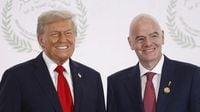Soccer fever is sweeping across North America as FIFA’s 2026 World Cup draws closer, and there’s no sign of the excitement slowing down. On October 16, 2025, FIFA announced that more than 1 million tickets had already been snapped up for the tournament, which is set to take place across the United States, Canada, and Mexico from June 11 to July 19, 2026. That’s a record-breaking pace for a World Cup still more than half a year away, and the numbers tell a story of global anticipation and high stakes—both on and off the pitch.
Demand has been especially intense in the host nations, with fans in the U.S., Canada, and Mexico leading the charge for tickets. According to FIFA, buyers from a whopping 212 countries and territories have already secured their seats, even though only 28 of the 48 teams have officially qualified for the tournament so far. Rounding out the top ten in ticket demand are England, Germany, Brazil, Spain, Colombia, Argentina, and France, reflecting the worldwide pull of the beautiful game.
“As national teams across the globe compete for a place at the historic FIFA World Cup 26, I am thrilled so many football-loving fans also want to be part of this watershed event in North America,” FIFA President Gianni Infantino said in a statement. “It’s an incredible response, and a wonderful sign that the biggest, most inclusive FIFA World Cup in history is capturing the imagination of supporters everywhere.”
But behind the celebratory headlines and surging ticket sales lies a complex and, for many, daunting reality: the price of admission is steeper than ever before. For the first time, FIFA has introduced dynamic pricing to World Cup ticket sales, and the result has been a dizzying range of costs depending on the match and the seat. While Category 4 seats—the lowest tier—start at $60, that price is only available for about 40 matches, and most games are set much higher. For fans hoping to catch the United States men’s national team (USMNT) in action, the sticker shock is real. The opening USMNT match, scheduled for June 12, 2026, at SoFi Stadium in Inglewood, California, saw Category 3 tickets listed at $1,640, Category 2 at $2,240, and Category 1 at an eye-watering $3,385 when sales opened. And if you missed out on those? Resale prices have soared to as much as $61,642 for a single seat, according to The Athletic.
The financial hurdles don’t stop there. Tickets for the World Cup final, set for July 19 at MetLife Stadium in East Rutherford, New Jersey, are listed on FIFA’s resale platform at prices ranging from $9,538 to $57,500 per seat. Even the lowest-priced tickets for the final—when available—start at $2,030, with premium packages fetching astronomical sums. FIFA’s official resale site has launched to help protect fans from fake listings and price gouging, but the basic rules of supply and demand are driving prices higher, especially for the most coveted matches.
This year’s ticket sales are being conducted in several phases. The initial round, which opened earlier this month, saw 4.5 million applicants enter a lottery for the chance to purchase tickets. Winners in this first phase were able to select seats in one of four categories, with Category 1 offering the best views and Category 4 typically situated high up in the stadium. The second phase opens on October 27, 2025, giving fans another shot through a lottery-style Early Ticket Draw, with single-match, team-specific, and venue-specific packages up for grabs. A third and final phase will be held after the group-stage draw on December 5, 2025, when all 48 teams are confirmed and the full match schedule is released. For those still hoping to attend, tickets will also be made available closer to the tournament on a first-come, first-served basis.
With 104 matches scheduled across 16 North American venues and a combined stadium capacity of roughly 7.1 million seats, the scale of the 2026 World Cup is unprecedented. Yet, it remains unclear just how many of those seats will ultimately be available to the public, as FIFA has not released a detailed grid of list prices or a breakdown of allocations per match or venue. What’s certain is that the tournament’s global appeal is stronger than ever, and fans are willing to pay a premium for a chance to witness history.
Of course, ticketing isn’t the only headline-grabber as the countdown to kickoff continues. Political intrigue has entered the fray, with questions swirling over the ultimate authority to decide where matches will be held. On October 16, 2025, FIFA issued a statement indicating that governments have the final say on the safety and location of World Cup matches in host cities—a notable shift from an earlier assertion by FIFA Vice President Victor Montagliani, who insisted that FIFA alone held jurisdiction. This came after President Donald Trump raised concerns about public safety in Boston and suggested he might move matches from the city if he deemed conditions unsafe. Trump claimed, “I would call Gianni (Infantino), the head of FIFA, who’s phenomenal, and I would say, ‘Let’s move it to another location.’ And he would do that. He wouldn’t love to do it, but he’d do it, very easily he’d do it. And this is the right time to do it.”
Media outlets interpreted FIFA’s latest statement as siding with the U.S. government, noting, as ESPN reported, “FIFA has acknowledged that the United States government has the final say on determining the safety of World Cup host cities.” This has sparked debate about the balance of power between national governments and international sports bodies, with some officials—like Montagliani—emphasizing the game’s independence from political leaders: “With all due respect to current world leaders, football is bigger than them and football will survive their regime and their government and their slogans. That’s the beauty of our game, that it is bigger than any individual and bigger than any country.”
Meanwhile, the tournament is drawing star power from other sports as well. On October 16, 2025, Los Angeles Lakers guard and Real Madrid fan Luka Doncic was announced as an official ambassador for the World Cup matches in Southern California. Doncic, who speaks four languages and hails from Slovenia, expressed his enthusiasm: “I’ve always been a football fan. Los Angeles is a great city full of amazing people who love to play and watch every sport. I can’t wait for the World Cup and it’s an honor to help bring people together through a sport that connects so many cultures around the globe.”
As the world waits for the final list of qualified teams and the full match schedule, anticipation is building by the day. From sky-high ticket prices and evolving security debates to the promise of unforgettable moments on the field, the 2026 FIFA World Cup is shaping up to be one for the ages. Fans lucky enough to have secured their seats are already counting down, while millions more hope their chance is yet to come. The road to North America’s biggest soccer spectacle is well underway—and the action is just getting started.





